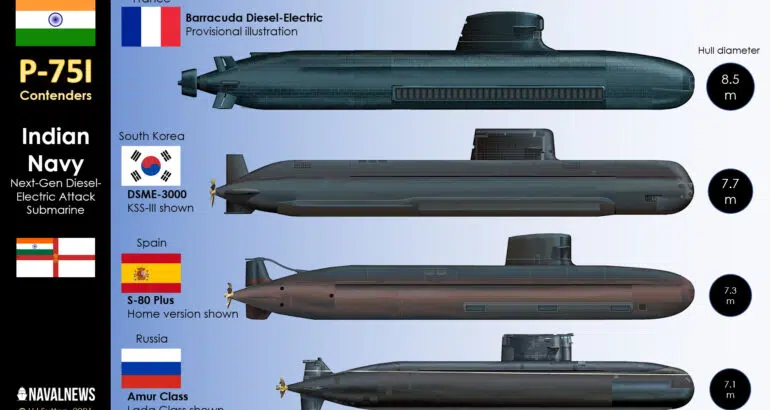Details of each competitor are at the link below
The 4 Submarines Competing For The Indian Navy’s P-75I Program
The 4 P-75I submarine designs are from France, South Korea, Spain and Russia.
Challenges are likely to include the Indian Navy's requirements for AIP (Air Independent Power). And possibly a vertical launch system (VLS) for Brahmos missiles.
The Indian Navy's P-75I submarines will be larger and much more potent than the Kalvari Class now entering service. They will be the bedrock of India's submarine fleet at a time when the strategic focus is leaning towards China as well as the traditional adversary, Pakistan. There are 4 contenders.
H I Sutton 14 Oct 2021
There are four contenders for the Indian navy’s next-generation P75I submarine. They are currently submitting design proposals to the Indian Government. Whatever the outcome the boats are expected to all be built in India. So the deal will factor in political and industrial considerations as well as naval requirements.
The four contenders are the Barracuda from France, the S-80-Plus from Spain, DSME-3000 from South Korea and Amur design from Russia. Germany had also been a contender but recently said that they dropped out.
All of the contenders have their merits and it is likely to be a tough choice for the Indian Navy. Below we outline the different designs.
The Indian Navy’s detailed requirements have not been shared. Based on reports and analysis of their current capabilities, investments and threat focuses, two things seem sure. The first is that P75I will have AIP (air independent power). The second is that they would prefer a VLS to launch Brahmos anti-ship missiles. Taken together, the P75I will have to be much larger than previous Indian navy conventional submarines.
Both the AIP and VLS will present challenges and difficult decisions. Like all major submarine projects, trade-offs will have to get made. India has developed its own fuel cell AIP which it is planning to fit to the current French-designed Kalvari Class (Scorpene type). This is a logical choice for the P75I also, particularly from the perspective of indigenous industry. However the Indian Navy is likely to be very interested in the AIP already available with the designs. Incorporating the local AIP would increase development risks, and close off opportunities to access better AIP systems.
The VLS will be a challenge because all the contenders are relatively small boats. It is unclear how dependent the contract will be on a VLS, or whether alternative missile options will be considered.

https://www.navalnews.com/naval-news/2021/10/the-4-submarines-competing-for-the-indian-navys-p-75i-program/
The 4 Submarines Competing For The Indian Navy’s P-75I Program
The 4 P-75I submarine designs are from France, South Korea, Spain and Russia.
Challenges are likely to include the Indian Navy's requirements for AIP (Air Independent Power). And possibly a vertical launch system (VLS) for Brahmos missiles.
The Indian Navy's P-75I submarines will be larger and much more potent than the Kalvari Class now entering service. They will be the bedrock of India's submarine fleet at a time when the strategic focus is leaning towards China as well as the traditional adversary, Pakistan. There are 4 contenders.
H I Sutton 14 Oct 2021
There are four contenders for the Indian navy’s next-generation P75I submarine. They are currently submitting design proposals to the Indian Government. Whatever the outcome the boats are expected to all be built in India. So the deal will factor in political and industrial considerations as well as naval requirements.
The four contenders are the Barracuda from France, the S-80-Plus from Spain, DSME-3000 from South Korea and Amur design from Russia. Germany had also been a contender but recently said that they dropped out.
All of the contenders have their merits and it is likely to be a tough choice for the Indian Navy. Below we outline the different designs.
The Indian Navy’s detailed requirements have not been shared. Based on reports and analysis of their current capabilities, investments and threat focuses, two things seem sure. The first is that P75I will have AIP (air independent power). The second is that they would prefer a VLS to launch Brahmos anti-ship missiles. Taken together, the P75I will have to be much larger than previous Indian navy conventional submarines.
Both the AIP and VLS will present challenges and difficult decisions. Like all major submarine projects, trade-offs will have to get made. India has developed its own fuel cell AIP which it is planning to fit to the current French-designed Kalvari Class (Scorpene type). This is a logical choice for the P75I also, particularly from the perspective of indigenous industry. However the Indian Navy is likely to be very interested in the AIP already available with the designs. Incorporating the local AIP would increase development risks, and close off opportunities to access better AIP systems.
The VLS will be a challenge because all the contenders are relatively small boats. It is unclear how dependent the contract will be on a VLS, or whether alternative missile options will be considered.

https://www.navalnews.com/naval-news/2021/10/the-4-submarines-competing-for-the-indian-navys-p-75i-program/



